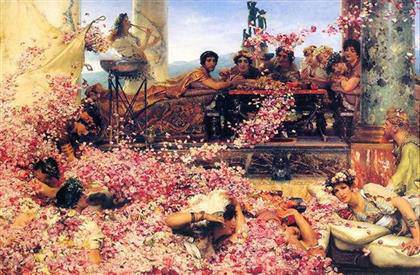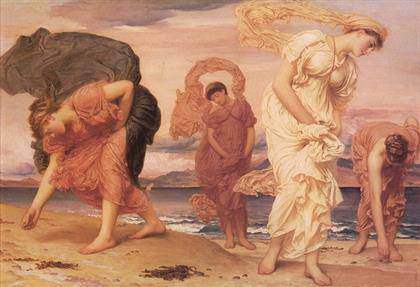
Lawrence Alma-Tadema
The Roses of Heliogabalus, 1888
© Colección Pérez Simón, México

Lord Frederic Leighton
Greek Girls picking up Pebbles by the Sea, 1871
© Colección Pérez Simón, México
Alma-Tadema and Victorian Painting at Museo Thyssen Thyssen-Bornemisza Museum presents ‘Alma-Tadema and Victorian Painting in the Pérez Simón Collection’, an exhibition that include paintings by some of the leading names in 19th-century English painting. 25 June to 5 October 2014.]]>
Source: Thyssen-Bornemisza Museum
The works of Lawrence Alma-Tadema, Frederic Leighton, Edward ColeyBurne‐Jones, Albert. J. Moore and John William Waterhouse express the values that these painters hadpartly inherited from the Pre-Raphaelites, presenting a strong contrast with the predominantlymoralising attitude of the day. Instead, they focused on classical antiquity, the cult of female beautyand a quest for visual harmony, all located in sumptuous settings and with a frequent use of medieval,Greek and Roman themes. Commissioned by Véronique Gerard-Powell, honorary professor at theUniversité Paris‐Sorbonne, the exhibition comprises fifty works from the private Pérez SimónCollection, one of the most important holdings of Victorian painting in the world, and has been shownin Paris and Rome before reaching Madrid, after which it will travel to London
Over the past thirty years Juan Antonio Pérez Simón has revealed a particular interest in Britishpainting created during the reign of Queen Victoria (1837‐1901) and her son Edward VII (1901-1910), aperiod in art that despite its popularity at the time has been largely ignored by museums andcollectors for almost a century. However, this period forms one of the principal focus points of JuanAntonio Pérez Simón’s wide-ranging collection and includes works of the importance of “Greek Girlspicking up Pebbles on the Beach” by Leighton, “The Quartet. A Painter’s Tribute to the Art of Music” byMoore, “Andromeda” by Poynter, “The Crystal Ball” by Waterhouse and “The Roses of Heliogabalus” byAlma-Tadema. The latter is extensively represented in both the collection and in this exhibition, whichincludes thirteen works by the artist.
The exhibition spans a chronological period that begins in 1860 with the break‐up of the Pre‐Raphaelite Brotherhood and concludes fifty years later with the outbreak of World War I, which wouldradically modify British taste. The display of the works in the exhibition is organised into six thematicsections: The Eclecticism of an Era; Ideal Beauty, Classical Beauty; Alma‐Tadema: Between HistoricalReconstruction and Fantasy; The Face, Mirror of Beauty; From the Pre‐Raphaelites to Symbolism; andBetween Tradition and Modernity.
The selection of works in the exhibition allows visitors todiscover how 19th‐century British art followed a different model tothat of the rest of Europe. At this period London was a leadingcultural capital in which the increasing activity of collectors anddealers encouraged the growth of the art market. An authenticrenaissance took place between 1860 and 1880 when artistsbegan to reflect on their own practice.
Related content
The Pre-Raphaelite Legacy at the Metropolitan Museum (exhibition, 2014)
Follow us on:


